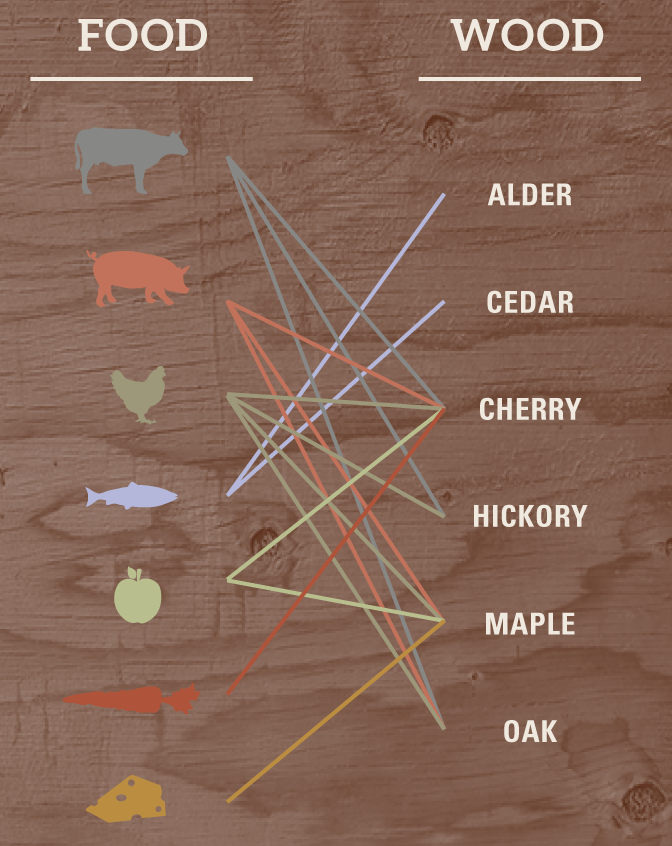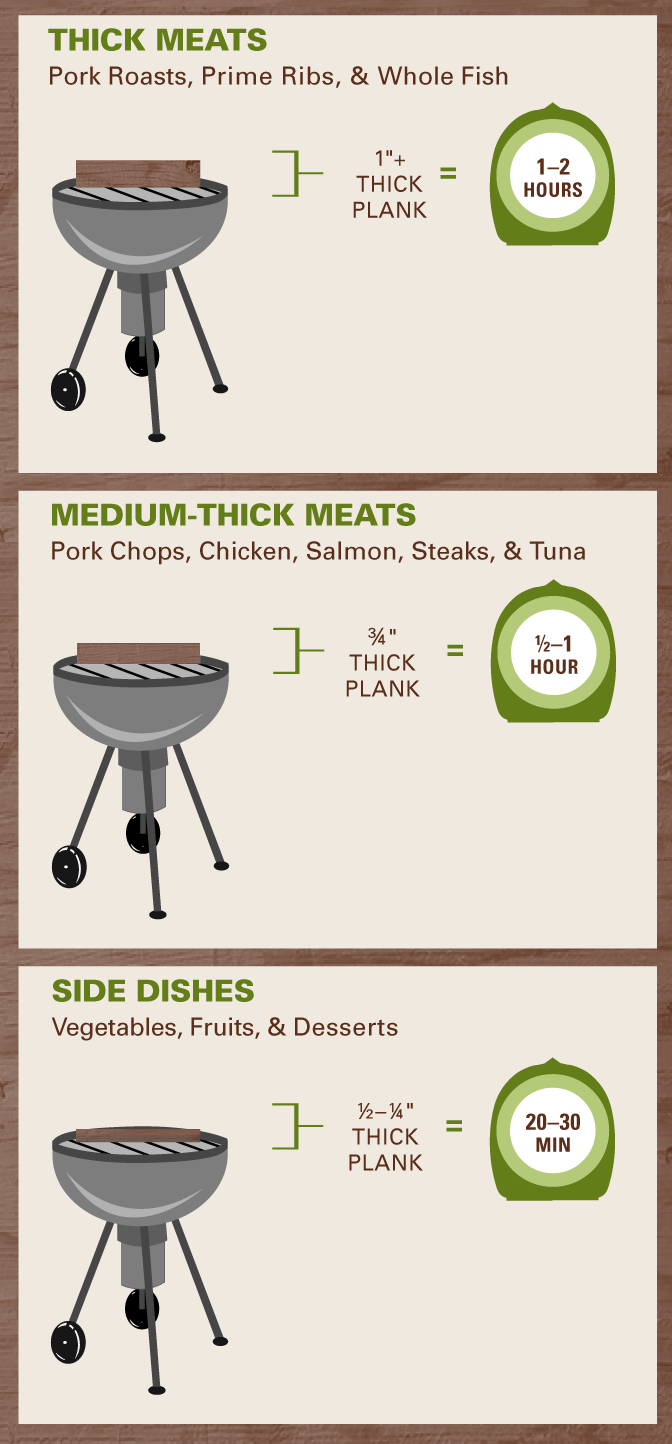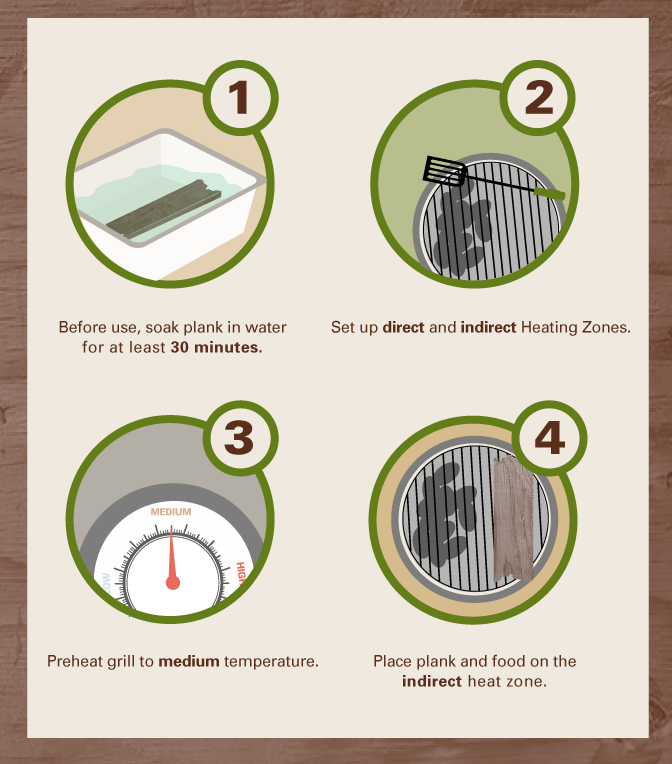Plank Grilling Pointers
Adding Flavor the Time-Honored Way
Planking is a great way to add smoky flavor to anything you put on the grill. Cooking on a plank transfers flavor from the wood as the food cooks.
Salmon on cedar is one of the more common types of planked food.
However, nearly any food can be cooked over a plank to add subtle smoke and make a creative presentation.
Planking probably began with Native Americans in the Pacific Northwest. They tied fish and game to Western Red Cedar and alder planks,
then placed them around an open fire to cook over the indirect heat. Over the centuries, the practice of planking has moved from necessity to art,
and now meats, poultry, vegetables, cheese, fruits, and even pizza can be cooked on a plank.
The smoky flavor is what makes planking so popular. As a plank warms up, the natural oils and moisture from the wood become
absorbed by the food. That transfer creates the flavor; different types of woods have their own distinct flavors.
Pick a Plank:
The type of food and the type of flavor influences the best wood choice for the plank.
However, all planks should be untreated wood. Also,
avoid planks made from trees that have sap; the resulting taste will be bitter.
The six most popular wood types used for planks include:
Alder is best used with seafood. It produces a light sweet flavor that doesn’t overpower. Alder is similar to cedar.
Cedar is the most well known type of plank. Commonly used with salmon, cedar pairs well with almost all seafood.
Cherry has a mild, fruitlike flavor. It can be used with a variety of meat, including beef, pork, and poultry. Fruits and vegetables are also a good match for cherry.
Hickory produces one of the strongest smoky flavors. Poultry and beef are excellent choices to pair with hickory.
Maple has a sweet and subtle smoky flavor that’s not as powerful as hickory or oak. Pork and poultry are the best selections for a maple plank.
A maple plank also enhances fruits such as peaches and cheese such as Brie.
Oak produces a medium, nutty, smoky flavor stronger than maple but not as powerful as hickory. Beef, pork, and poultry all benefit from oak planks.

After wood type, plank thickness is the second key factor in a successful plank-grilled meal. The shorter the time an item needs to be cooked, the thinner the plank.
Thick Meats
- Pork Roasts, Prime Ribs & Whole Fish
- Cooking Time - 1 to 2 hours
- Plank Thickness - 1"+
Medium–Thick Meats
- Pork Roasts, Prime Ribs & Whole Fish
- Chicken, Pork Chops, Steaks, Salmon & Tuna
- Plank Thickness - 3/4"
Side Dishes
- Desserts, Fruits & Vegetables
- Cooking Time - 20 to 30 minutes
- Plank Thickness - 1/4" to 1/2"

Prepare the Plank:
Before cooking with planks, you must soak them in water for at least 30 minutes. Soaking the planks eliminates the fire risk from using wood on the grill.
Prepare a grill for medium heat, with both direct and indirect cooking zones. Create cooking zones on a charcoal grill by moving the charcoal to one side: the side with no charcoal is the indirect cooking side. On a gas grill, simply leave two burners off.
The planks are placed on the “indirect" side of the grill; the food roasts on the planks while absorbing the smoky flavor from the wood. Grilling time varies, based on the food.

Planking Practice Recipes:
For the recipes below, prepare planks and grill as instructed above, then serve the finished food still on the plank.
Smoked Cheese: Place Brie or Camembert on a cedar plank and smoke for up to 20 minutes until the cheese begins to brown and melt.
Add fresh herbs, nuts, dates, craisins, balsamic glaze, or other toppings as desired.
Cedar-Planked Salmon: Melt butter, mix in fresh dill, salt, and pepper, and brush over salmon. Grill at 350 degrees Fahrenheit on indirect
heat until an internal-read thermometer reads 140 degrees. Grill lemons on direct heat until char marks form; serve with the salmon.
Alder-Smoked Shrimp: Drizzle shrimp with olive oil, salt, pepper, and a dash of cumin.
Smoke for five minutes or until shrimp turns pink. Finish with fresh-squeezed lemon.
Maple-Planked Chicken: Make a seasoning paste of orange zest, oregano, olive oil, salt, and pepper. Rub this on chicken thighs. Cook on a plank until an internal-read thermometer reads 170 degrees.
Planked Flatbread Pizzas: Generously spray the plank with nonstick cooking spray and then dust with cornmeal so the dough does not stick.
Use store-bought or homemade dough; roll out on plank. Grill the planked pizza dough until it begins
to rise – about 5 minutes or so – and then add cheese and other toppings, perhaps including precooked meat.
Grill pizza for another five minutes or until the cheese begins to melt and gets bubbly.
Planked Dessert Fruit: Drizzle stone fruit such as peaches with honey and cinnamon and grill until the fruit begins to caramelize. Serve with ice cream, if desired.
Reusing Planks:
Planks can be reused two to four times. Since the flavor of the food may transfer to the plank, reuse planks with the same type of food.
Do not use soap; scrub the planks with a brush and water, then let them air dry to prevent mold.
Store them in an airtight container until the next use.
Embed the article on your site

